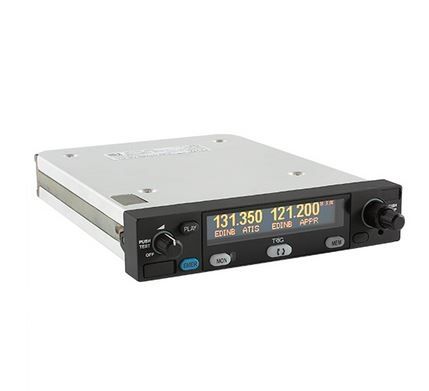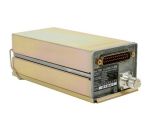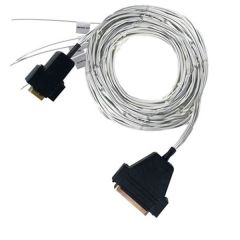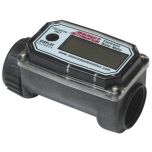Trig TY96 VHF Stack Radio
Trig TY96 VFH Stack Radio
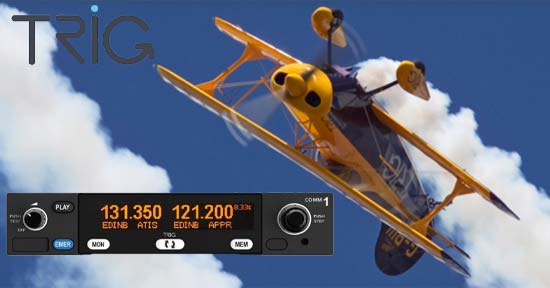

General Description
Trig TY96 VHF Stack Radio - has defined a new standard in design and is packed with pilot friendly features. The radio provides crisp and clear stereo communication, faster tuning, a user friendly programmable USB database, dual watch and Trig’s popular ‘Say Again’ feature.
Combining great quality and performance each radio is housed within a superbly engineered unit, slimline and light. At only 33mm high (1.3”) the radio saves valuable stack space, but retains innovative and practical features. Trig’s stack radios are designed for general and light-sport aviation, with features that both experienced and novice pilots really appreciate.
The TY96/TY97 is an 8.33 radio, the TY96A/TY97A is a 760 channel only version.
Fit Trig and start enjoying improved communications on every flight you make!
Features
- Slimline – only 33mm high
- Bright, clear display / simple user interface
- Unique ‘Push Step’ for faster tuning
- Dual Watch – monitor two frequencies at the same time
- ETSO and TSO approved
- Stereo music / two place intercom
- ‘Say Again’ feature – allows playback of last transmission
- Emergency button
- Configurable airfield database – holds over 200 frequencies
- USB port on facia – upload frequency database (CSV file)
- Highly efficient – no cooling fans or external cooling required
- Ideal retro-fit for legacy radios – same height as an SL40
- Unbeatable quality – designed and manufactured in the U.K.
- Two year worldwide warranty
The TY96A is a 10 Watt model, suited for most general aviation use. The TY97A is a more powerful 16 Watt model, where a higher transmission output is required.
The display is clear and bright, showing both primary and secondary frequencies along with ICAO or custom set airfield identifiers. A ‘Push Step’ knob allows the fastest change from 50 kHz to 25 kHz steps - so you can tune the radio quickly without compromising your look-out. The Dual Watch feature allows two frequencies to be monitored at the same time - it’s like having two radios in one.
| TY96 / TY96A Radios | TY97 / TY97A Radios |
| Type | Certified |
| Certification | ETSO 2C128, 2C169a TSO-C128a TSO-C169a |
| Compliance | ED-23C, ED-67, DO-186B, DO-178B Level B, DO-160G, DO-254 Level C |
| Supply voltage (DC) | 11 – 33 V | 22 – 33 V |
| Typical consumption (at 14v) | (at 14V) receive: 175 mA transmit: 2A | (at 28V) receive: 250 mA transmit: 2.5A |
| Nominal Transmitter Power | 10 Watt | 10 Watt |
| Operating temperature | -20°C to +55°C |
| Cooling requirement | no fan required |
| Weight | 0.95 kg / 2.09 lbs |
| Dimensions (mm) | 33 x W 159 x L 270 mm |
| Installed depth in tray (mm) | 230 mm long |
| Dimensions (inches) | H 1.3” x W 6.26” x L 10.63” |
| Installed depth in tray (inches) | 9.05” long |


TY96 VHF Radio Items
- TY96 VHF Radio 1 01226-00-01
- TY96/TY97 Installation Kit 1 01472-00
- TY96/TY97 Mounting Tray 1 01368-00
- TY96 TY96A and TY97 TY97A Pilots Operating Handbook 1 01239-00
TY96A VHF radio Items
- TY96A VHF Radio 1 01787-00-01
- TY96/TY97 Installation Kit 1 01472-00
- TY96/TY97 Mounting Tray 1 01368-00
- TY96 TY96A and TY97 TY97A Pilots Operating Handbook 1 01239-00
Installation Kit
- Connector Mounting Plate 1 01369-00
- Connector Standard Mount 25 Way D receptacle to M24308 1 00866-00
- Crimp Socket Contact, Wire size 20-24 AWG 25 00730-00
- D-Sub Shell 1 01440-00
- D-Sub Shell Clamp 1 01441-00
- D-Sub Shell Cover 1 01442-00
- BNC Female to Blind Mate Adaptor 1 01410-00
- Washer, 7/16", Plain, Stainless Steel 1 00241-00
- Circlip, 7/16", External, Stainless Steel 1 00242-00
- Washer, 7/16", Wave, Stainless Steel 1 00317-00
- Screw, Pozidriv, Csk Head, M2.5 x 5mm, Pre Patch 2 01020-00
- Screw, Pozidriv, Pan Head, M2.5 x 5mm, Pre Patch 6 01021-00
- Screw, Pozidriv, Pan Head, M2.5 x 8mm, Pre Patch 4 01024-00
- Screw, Philips Csk head, 4-40 UNC x 0.312", Pre Patch 2 01397-00
- Washer, M2.5 Rect Sect, Spring 6 01473-00
- User Label Sheet 1 01412-00
- USB Flash Drive 1 01646-00
Required Items
Additional items you will require, but which are not in the TY96/TY97 package, include:
- Antenna and fixing hardware. The TY96 or TY97 are compatible with any standard 50 ohm vertically polarised antenna with a VSWR better than 2.5:1.
- Cables. You need to supply and fabricate all required cables. Guidance on cable types is given in section 5.
- Fixings. To secure the VHF radio tray to the airframe you will need at least 6 flat head screws and self-locking nuts. If the aircraft does not have existing mounting provisions you may need to fabricate additional brackets to support the VHF radio tray.
Existing wiring provisions from a previously installed radio may be re-used provided it is in satisfactory condition.
Is the Trig stack radio a plug and play retro fit radio?
The Trig stack radio is not a plug and play product. The radios offer features such as, stereo intercom and support for stereo music. To exploit these features some re-wiring is required. However, the radio is shorter, lighter and comes with a Trig tray to make replacement of an existing radio as practical as possible. The installation manual provides wiring information on legacy radios to help configure the installation.
How does the 'Push Step' feature affect 8.33kHz tuning?
The 8.33/25K push step does not affect the mode of the radio. You cannot turn off the 8.33 capability. The push step is only changing the size of the steps when you are tuning. It's there to make tuning faster – 4 times less turns to reach your desired frequency.
For example, if you tune to an 8.33 channel, then click the push step to display the small 25k symbol, then you are still transmitting and receiving on the 8.33 channel you selected, only the size of the tuning steps changes for when you next turn the tuning knob.
How do I create my USB frequency database?
Each radio is shipped with a Trig USB stick. This contains full instructions for the product in the form of the User Manual and Installation Guide - TY96/96A /TY97/97A.
The same Trig USB is used for uploading a frequency database, that you create. Each stick contains a sample database file. A PC or laptop is required with a USB port to configure and load the USB stick.
Once the USB is plugged in, open the CSV file that is saved on the memory stick. This file can be opened with either a notepad or spread sheet application, such as Microsoft Excel. This file has a few sample frequencies already saved. Follow the same convention and add all radio channels that you would like. The Trig USB enables you to create a unique database for yourself. You can save up to 250 frequencies on your Trig stack radio.
Alternatively you can create a frequency database at https://www.trig-avionics.com/support/trig-radio-database/
How do I load my database from my USB onto my radio?
Once you are happy with your database, save this to your memory stick. To load or save this to your radio, you need to put the memory stick into your radio’s USB port when the unit is turned off.
Only when the radio is then powered on, it detects the USB stick and will offer to save or load your database. If there are data entries already on your radio you will be offered the choice to replace the whole database, or add entries from the USB stick. Similarly, if there is already a database on the USB stick you can either overwrite it or add the radio data to the existing file.
To return to normal radio operation, remove the USB device and switch the radio off and then turn it back on again.
In normal radio operation, the USB port is powered off.
Can I link this radio to my GPS? To push frequencies to SBY?
Yes – You can use any GPS system that can push this information using the Apollo SL40 protocol($PMRRC)
Can I play music through this radio?
Yes – The Trig stack radio has a dedicated stereo music input. This has its own independent volume control and can be set to automatically mute on inbound transmissions.
Can the TY96/97 interface with my existing audio panel/external intercom?
Yes – The Trig stack radio has a dedicated mono audio output for interfacing with standalone audio panels/intercoms. Full details of these connections can be found in our installation manual with examples for the most common units.
Can I use CS-STAN to install a Trig radio?
Trig has created a CS-STAN document to help with your TY96/TY97 installations in EASA aircraft. To find out more about how to use a CS-STAN document – click here.
If I am required to comply with the ICNIRP public limits for my aircraft radios, what do I need to do?
The ICNIRP is the International Commission on Non-Ionizing Radiation Protection, and they have proposed limits on the amount of radio frequency energy that the public should be exposed to. These limits cover every transmitting source, from TV stations to 5G mobile phone masts, and includes aircraft radios.
Because the amount of energy that reaches a body is a function of the distance from the transmitter, and because we know the transmit power of our radios, we can work out the safe distance that must be maintained to meet these limits. Fortunately, the average power of our radios is low compared to most broadcast transmitters, and therefore our safe distances are very small. For any Trig transponder, although the instantaneous pulse power is high, the duty cycle and the total transmitter-on time is so short that the average power is well below the 10 W applicability limit for ICNIRP, and therefore your transponder is not affected by ICNIRP.
For our VHF radios, although you probably don’t transmit all the time, it is certainly possible to exceed the 10 W limit. That is even true for our 6 W rated transmitters - because the ICNIRP limit takes account of the antenna gain and directionality, and the field strength can be higher than the nominal power. You therefore need to consider the safe distance for these radios between the transmitting antenna and any member of the public. The actual safe distance will depend on the transmitting antenna configuration, but we have calculated the distances for conventional aircraft antennas.
Allowing for typical antenna cable losses, for our 16 W radios, such as TY97 and TY92, the safe distance is about 1.8 metres or 6 feet. For our 10 W radios, such as TY96 or TY96A, the safe distance is about 1.51 metres, or 5 feet. Finally, for our 6 W radios the distance is about 1.17 metres, or 3 feet 10 inches.
You can see that none of these distances will affect members of the public near to your aircraft in flight, or even whilst operating on the ground. The definition of “general public” also does not include the pilot of the aircraft, or anyone involved in operating the aircraft – they are assumed to be aware of the risks, and to have taken an informed decision to participate.
The “general public” however, does include passengers. You therefore need to consider the orientation of the passenger seats in relation to any transmitting antenna, and the extent to which they are shielded by the cabin structure and by any ground plane provisions. For many metal aircraft the construction means that the occupants are naturally shielded from transmissions, making this less of an issue. For other types, you may need to perform more analysis. Solving that is outside the scope of this FAQ. for information about the ICNIRP see www.icnirp.org
Versions
| Model | 8.33 kHz Capable (Required in Europe) | 760 Channel Radio (Outside of Europe) | Nominal Power Output | Supply Voltage |
| TY96 radio | Yes | No | 10W | 11-33V |
| TY97 radio – high power | Yes | No | 16W | 22-33V |
| TY96A radio | No | Yes | 10W | 11-33V |
| TY97A radio – high power | No | Yes | 16W | 22-33V |
EASY TO USE
The stack radio display is clear and bright, showing both primary and secondary frequencies along with ICAO or custom set airfield identifiers. A ‘Push Step’ knob allows the fastest change from 8.33 kHz to 25 kHz (TY96/TY97) or 25 kHz to 50 kHz (TY96A/TY97A)- so you can tune the radio quickly without compromising your look-out.
The Dual Watch feature allows two frequencies to be monitored at the same time – it’s like having two radios in one.
The user configurable database, allows over 200 frequencies and identifiers to be downloaded to the radio from a CSV file – using the USB stick (provided). There are no subscription fees and this provides a highly flexible way to customise the radio for every flight by every pilot – perfect for fleet or club aircraft. Create your database here.
SAY AGAIN
The radio has a ‘Say Again’ feature. A single button press replays the last radio transmission. This feature is ideal for student pilots, but every pilot can get distracted, so it avoids the embarrassment of asking air traffic to repeat a message. A one touch Emergency Button automatically sets 121.5 MHz, along with volume levels. This ensures a successful transmission in what can be a stressful situation.
INTERCOM
Each radio has a built in two place intercom with auxiliary inputs for stereo music and audio warnings. Each radio can also integrate with a GPS navigator (SL40 and GTR225 protocol) to automatically display frequencies as they are required along the flight route. Finally, an airfield database can be loaded via the handy USB port. This database can contain over 200 of your preferred frequencies and identifiers.
PRODUCT DESIGN
The radio’s low profile design requires no external cooling fans. The radios compact size and features make it a great choice for both forward and retro-fit installations. Each radio is designed to easily integrate with legacy radios, these include popular KY 196A, KY 197A and SL 40 models.

